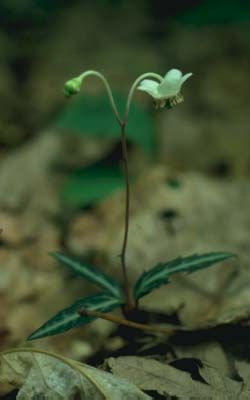Chimaphila maculata (L.) Pursh - Spotted Wintergreen

Spotted Wintergreen
Photo © Steven Clemants, 1992, taken on Shelter Island, New York.
Common Names
Spotted WintergreenField Identification
An herb or subshrub with white veins on dark green leaves.Food uses
Disclaimer: The information provided here is for reference and historical use. We do not recommend nor do we condone the use of this species for food purposes without first consulting a physician.The dried leaves are slightly astringent, and the plant has been employed as a tonic and diuretic.
Nomenclature
*Pyrola maculata L., Sp. Pl. 1: 396. 1753. *Chimaphila maculata (L.) Pursh, Fl. Amer. Sept. 1: 300. 1814. *Pserva maculata (L.) Kuntze, Revis. Gen. Pl. 2: 390. 1891. TYPE: United States. Virginia: Clayton 88 (Lectotype: BM), selected by (Reveal, 1987).*Pyrola (or Chimaphila) durani Raf., Atlantic J. 119. 1932. *Chimaphila maculata var. duranni (Raf.) Raf., Autik. Bot. 105. 1840. TYPE: United States. Maryland: near Baltimore, Mr. Durand s.n. (Holotype: ?)
Description
HABIT perennial, evergreen, chamaephyte, subshrubs, autotrophic, monoclinous, with fibrous roots and with adventitious roots, 0.1-0.3 m tall, not modified or with rhizomes.STEMS erect, round, not winged, "regular". Prickles absent. Bark ridged, not exfoliating, reddish violet or dark violet-red. Branches erect, dark violet-red, round (or ridged), not winged, 1-1.7 mm in diam. Twigs dark violet-red, not odoriferous, round or ridged, 1-1.7 mm in diam., smooth, glabrous, without glands. Pith present, white, round, continuous. Thorns absent. Aerial roots absent. Sap translucent. Resin absent.
LEAVES alternate or subopposite or opposite or whorled, 1-3 per node, crowded toward stem apex, divergent from stem, simple. Stipules absent. Leaves petiolate, petiole "typical", 0.3-0.6 cm long, glabrous, without glands. Leaf: abaxial surface dark green, adaxial surface light yellowish green or dark yellowish green or dark bluish violet or dark violet-red (with white or light greenish yellow veins), blades narrow oblong or lanceolate or oblong or ovate, plane, symmetric, 2.1-5.9 cm long, 0.7-2.5 cm wide, coriaceous, base obtuse or acute, margin serrate, apex acuminate, abaxial surface glabrous, without glands, adaxial surface glabrous, without glands. Eucamptodromous venation, veins 3-4. Leaf lobes absent. Spines absent. Tendrils absent.
INFLORESCENCES monomorphic, regular or, if dimorphic, female inflorescence simple, umbel, terminal. Peduncle present, 4.2-6.7 cm long. Rachis absent, with bracts. Bracts sessile, blades: abaxial surface orange, adaxial surface orange, obovate, involute, 4.5-6.3 mm long, 1-3 mm wide, base obtuse, margin ciliate, apex acuminate, abaxial surface glabrous, without glands, adaxial surface glabrous, without glands. Pedicel 10-18 mm long, hairs short and unbranched, hairs erect, unicellular, uniseriate, white, moderately dense, throughout, not glabrescent, glands present or without glands, glands at apex of hairs. Bracteoles 2, sessile, at midpedicel, not connate, bracteoles: abaxial surface dark reddish orange, bracteole: adaxial surface orange-yellow, linear, plane, 2.3-3 mm long, 0.2-0.3 mm wide, base acute, margin serrate, apex acute. Cupules absent.
FLOWERS serotinous, formed on short shoots, monomorphic, with sepals and petals readily distinguishable from one another, bisexual, flowers white, 5-merous, 10-15 mm long, 17-23 mm wide, 1-3(-5) flowers per inflorescence, fragrance present, perianth of two whorls. Calyx present, actinomorphic, acetabuliform (?), of free sepals, persistent, abaxial and adaxial surfaces the same color, dark orange or light greenish yellow, 2.1-3.5 mm long, 6.4-7 mm wide. Sepals or sepal lobes 5, rhombic to obtrullate, 2.1-3.5 mm long, 1.9-2.3 mm wide, base truncate, margin ciliate, apex obtuse (rounded), abaxial surface glabrous, without glands, adaxial surface glabrous, without glands. Epicalyx absent. Corolla present, actinomorphic, acetabuliform (?), of free petals, deciduous, abaxial and adaxial surfaces the same color, white, uniform, 7-13 mm long, 14.5-17 mm wide. Petals or petal lobes 5, "normal", widely elliptic to widely oblong, 7.5-8.5 mm long, 3.5-4.7 mm wide, base acute, margin ciliate, apex obtuse, abaxial surface glabrous, without glands, adaxial surface glabrous, without glands. Gynoecium syncarpous. Carpels 5. Stigmas 1, broadly capitate. Styles persistent, 0, style absent, the stigma sessile on the ovary. Ovary superior, 2-6 mm long, 4-9 mm wide, nectiferous disk present. Locules 5. Placentation axile. Androecium obdiplostemonous. Stamens 10, 4.2-5.6 mm long. Anthers ovoid, opening by pores, opening 1/4 of entire anther, bithecal, light orange-yellow, glabrous. Filaments free, straight, bluish violet, hairs long and unbranched, erect, unicellular. Staminodes absent.
FRUITS loculicidal capsule, orange or dark orange-red or greenish yellow, depressed globose, 4-7 mm long, 4-7 mm wide, glabrous, without glands.
SEEDS many, light orange-yellow or orange-yellow, fusiform, 0.4-0.6(-0.8) mm long, 0.1-0.2 mm wide, wingless, tailed, ribbed.
Habitat
Oak, pine, and hemlock woods. On dry or moist, often sandy soils with a pH averaging 5.5.
Rarity Status
Heritage global rank -- G5Connecticut -- not listed
New Jersey -- not listed
New York -- not listed
Species Biology
FloweringMay [week 2]) Jun [week 3] - Aug [week 2] (Sep [week 2]).
Pollination
(Standley et al., 1988)Melittophily -- Principally pollinated by bumble bees (Bombus) particularly B. perplexus Cr. Not buzz-pollinated.
Fruiting
(June [week 1]) July [week 2] - Oct [week 4] (Jan [week 1]).
Dispersal
Anemochory -- Probably wind.
Germination
Unknown.